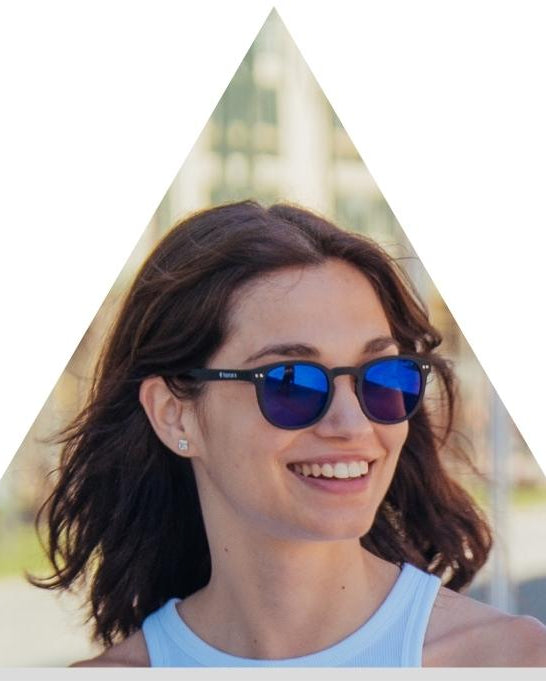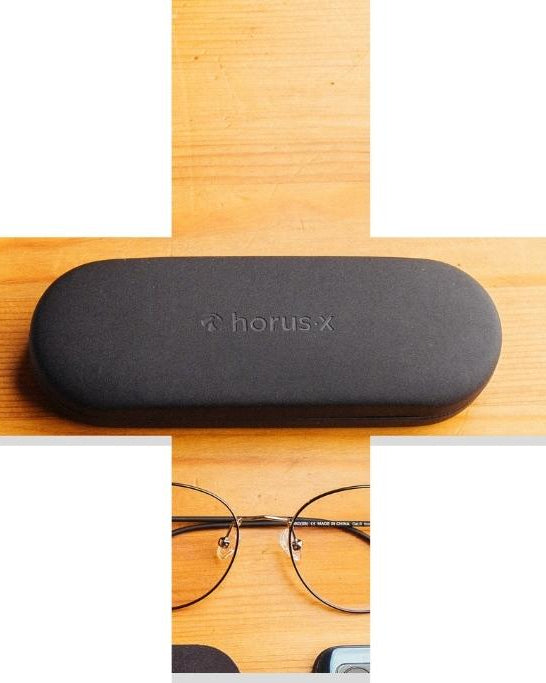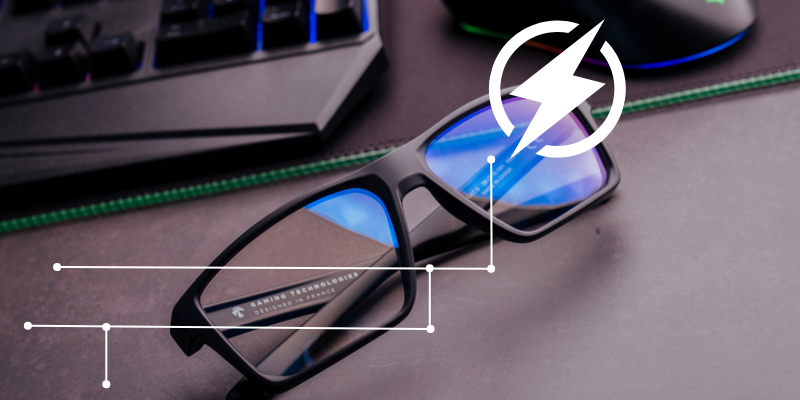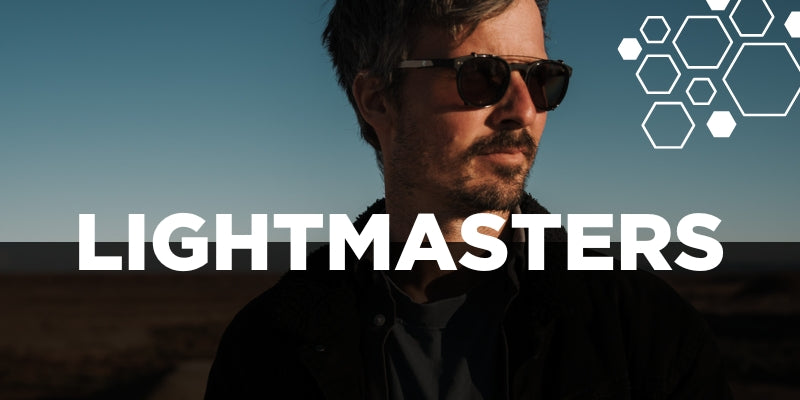🦇 It's not just Batman who drives at night: it's you too. Night driving can quickly become a hassle, even for the most seasoned driver: streetlights, reduced visibility around curves, idiots driving with full beams...
In short, being a night driver is no walk in the park, and it might require glasses with specially adapted lenses.
As you might guess, in this article we won't focus on the rules of the road, but on night driving glasses, to see better in the dark, especially on the road. Let's discover together how they work, what they're for, and which glasses to choose!
What's the problem with night driving?
Well, it's a lot of things. Starting with...
Night driving is tiring 🥱
👉 Fatigue, of course! After a long day of classes/work/existential crisis curled up on your couch, taking the wheel is complicated. Enough to make you drowsy, even fall asleep. You won't feel it coming—maybe just a stiff neck and heavy eyelids—so be careful!
Since visibility is reduced, we concentrate more. And the more we concentrate, the more tired we get. A vicious circle...

Imagine adding a bit of rain, heavy traffic, a sudden warning light, Godzilla rampaging through Tokyo... You get it, you'll need to spend a lot of energy just staying focused.
🚨 Quick tip: even mild dehydration increases fatigue. So, remember your water bottle!
At night, it's easy for cats (but not for our eyes) 😸
You can't rely too much on your eyes either. Sure, humans don't see that badly at night: you even have rods in your retina dedicated to that purpose.
But to adapt to darkness, your eyes will take... several minutes! Enough to cover several kilometers. Okay, a bit of detail:
- ⌚ Sudden change in brightness: 5 seconds for your pupils to stabilize.
- ⏲ 3 minutes for the rapid phase of dark adaptation.
- ⏲⏲⏲ Up to an hour for maximum adaptation.
😣 The thing is, you obviously can't wear sunglasses... Fine for style at a club entrance (we're tolerant at Horus X), but much less so when driving at night. Glare is extremely dangerous. You know it: you've probably already met a car with full beams (95% chance), been dazzled by a light reflection on a window (50% chance), or spotted a blinding meteorite (0.1% chance on an empty stomach, and of course, you drive on an empty stomach, IT'S IMPORTANT).

😖 On top of that, retinal persistence will distort your vision for several minutes. At 130 km/h on the highway, that doesn't forgive!
Speed and distance evaluation becomes harder, and contrast perception is disrupted. It's like trying a headshot on an old PC with minimum graphics settings, a trackball, and 24 fps: tough.
🚨 Quick tip: if you encounter full beams, look at the white line at the bottom right of the road as you approach. You'll temporarily use your peripheral vision and won't be dazzled. And you can console yourself knowing that if there is a hell, IT GOES STRAIGHT THERE.
And also the day before
🍻 Alright, let's be honest: alcohol is not cool (sorry torchbearers). At least not before driving, unless you enjoy the peculiar smell of the detox room... and the proximity of unfriendly roommates. Too much impact on driving!
🍔 A heavy meal (digestion is tiring), a bad night the day before, thoughts stuck on work... Lots of things that can increase accident risks.
As you might guess, night driving conditions are far from optimal; it's no wonder that the risk of a fatal accident is seven times higher!

Night Driving Glasses: What Are They?
No, we’re not talking about Cyclops’ visor from the X-Men! We mean glasses against glare and reflections, designed to amplify residual light and let you see like a cat (or almost) in the dark.
They still look stylish, but are mainly essential if you want to drive with better visibility and avoid eye strain.

Basically, there are 2 types of technologies for night driving without crashing into a pole (apart from staying sober and looking ahead, of course):
- 🚨 Active vision glasses (infrared): They have a small infrared emitter that projects light invisible to the naked eye. Magic: the glasses then translate darkness into a clear image. Mostly used as night vision glasses by security pros or hunters, for example—not really our topic here.
- 👓 Passive vision glasses: They amplify existing light while reducing the drawbacks of night vision. This is the type of glasses we’ll focus on in this article.
In short, these are usually tinted glasses (yellow lenses) designed to reduce reflections, limit glare (again, driving full-beam all night is dangerous: there’s a special place for you in hell, just so you know), and adjust light levels for better visibility.
Which Glasses for Night Driving: What Works (and What Doesn’t)
Prescription Glasses 👓
🕵️♂️ Let’s be a bit elementary, my dear Watson, but the first thing to do is to wear prescription glasses if you need them.
Don’t worry, many of us need visual correction, at least for comfort. So avoid hitting the road without the right prescription glasses.
Prescription glasses, really useful for seeing at night? Absolutely, approved! 👍
Night Driving Glasses with Yellow Lenses 🟡🟡

They enhance contrast. Yellow pigment is known to help the eyes see shapes in low light. Better shape perception means better vision, and better vision is good. Especially since this tint reduces the impact of glare on the retina. Begone, Mr. Full Beams, you have no power over me!
Speaking of glare, the color filter also helps reduce reflections and halos from external light sources. We explain everything about the usefulness of yellow lenses here, because they’re also handy for other activities (gaming, shooting, shooting in gaming…).
To be perfectly honest, there’s a study showing that yellow lenses don’t actually improve pedestrian detection at night. They won’t do all the work for you! However, drivers report increased comfort. And we take that.
The glasses are perfect for night driving. Headlights are much less harsh, and I’m no longer dazzled by every car I pass.
Happy with my purchase, effective product for night driving, reduces glare well and enhances contrasts.
These are real customer reviews of our TAC night glasses (mentioned below). You can check them out on the product page: Horus X night driving glasses yellow HD lenses.
So, yellow lenses, useful for night driving? Approved 👍
👉 PS: Brown-tinted glasses also work, but don’t choose lenses that are too dark—you’ll see much less.
Anti-Reflective Coating ✨

Ever notice halos around headlights/streetlights/other light sources at night? Anti-reflective coating is very effective at night—as well as during the day!
Be careful when cleaning: the coating is on the surface, don’t remove it. But it’s worth it—say goodbye to distracting lights for clear vision, even when switching between dashboard and road.
What’s anti-reflective coating for? We explain it all here.
Glasses with anti-reflective lenses, useful for night driving? Approved! 👍
Polarized Sunglasses: Good or Bad Idea at Night?
- By eliminating surface reflections, polarized lenses improve vision... but mostly in very bright environments!
- No need to say that moon reflections never gave anyone a tan. So UV protection? Not useful at night.
- They make reading LCD screens harder, so not practical for modern car dashboards.
- They let in slightly less light. You don’t want to see even less when light is already low.
👉 Careful: we’ll recommend them for daytime driving: in bright conditions, polarized lenses work best.
So, polarized lenses for night driving? Great for daytime, but at night: NO 👎

Blue Light Lenses
Blue light glasses, i.e., screen glasses, are our specialty at Horus X. They protect your eyes while working or while gaming.
But they don’t have a direct use while driving… well, except against LED and halogen headlights, and maybe against those roadside ads you encounter.
👉 Technical point: Blue light reduces or stops melatonin production, disrupting your circadian rhythm if you’re exposed too long. Basically, you’re like a well-tuned clock, and don’t mess with your body, or you risk poor sleep. That’s for sleep, but harmful blue light rays can do worse.
For moderately light-sensitive people, our clear-lens models are a good alternative: they filter 61% of the most intense blue light (380–450 nm). Less strong than the yellow lenses in our night driving glasses, but enough to reduce eye strain and improve visual comfort in bright environments, especially in the city.
So, at night behind the wheel, our blue-light glasses are of limited use. If I wear my Ushuaia Silver, it’s just because they look cool.
Blue light glasses for driving: neither useful nor harmful, neutral as a 🇨🇭
Never Use Category 4 Lenses for Night Driving
😎 Perfect for the mountains, the Arctic tundra, or your Gilbert Montagné cosplay, category 4 sunglasses are banned while driving, day or night: they block too much light.
Category 4 lenses at the wheel, NEVER, not even under tropical sun, no no no.
How to Choose Your Night Driving Glasses

Active or Passive Vision?
The choice is yours. Active vision is effective but more expensive, sometimes less comfortable, and requires a power source (rechargeable batteries or not). Passive vision, on the other hand, is more accessible and versatile. Bonus: you’ll have a slightly wider range of models to choose from.
Focus on Quality
We’re talking safety and comfort here, so don’t skimp on quality. Pay particular attention to lens quality, certifications, and standards (remember: the CE logo isn’t just for decoration). We recommend TAC lenses (Tri Acetate Cellulose) that provide a clear, distortion-free view.
Don’t Neglect Anti-Reflective Coating
As mentioned above, when driving at night, it’s better to avoid reflections. Yes, an anti-reflective coating is useful, far from being a gimmick, especially in this situation. And not all anti-reflective coatings are created equal!
Comfort and Ergonomics
If you’re going to wear glasses, make sure they’re comfortable, lightweight, and fit the shape of your face. Keep in mind you’ll wear them for long periods, and the less you feel them, the better.
Value for Money and Warranty
Good night driving glasses are great, but at the right price, it’s even better. And the right price isn’t Philippe Risoli-level, it’s neither too high nor too low. Take the time to compare different models, but also check the warranty.
Where to Buy Your Night Driving Glasses?
To make sure you choose well, go for reputable brands offering quality models: specialists like Pulsar, ATN, or Bushnell, and of course, Horus X!
If you’re looking for a simple, accessible, and effective solution for night driving, we’ve got you covered: Horus X TAC night driving glasses with yellow high-definition lenses (€29.90). Unlike standard polarized lenses, this model maintains a perfect balance between filtration and brightness, ideal for a more comfortable and safe night drive.
Weighing only 19 g, their ergonomic, lightweight frame disappears on your face, even during long drives. And because we believe in their durability, they come with a lifetime warranty.
Other Tips to Improve Night Driving

👉 Don’t drive (-> OK, stepping out).
Actually, we mean take breaks, don’t do long drives without stopping. That’s only for Forest Gump, and he was on foot. At the first sign of fatigue (and every two hours—this is a road safety message), stop, stretch, breathe… and get back on the road refreshed!
Signs of fatigue behind the wheel:
- 🔩 Neck stiffness
- 🥱 Repeated yawning
- 😣 Eye irritation
- 🦥 Slower reactions
- 🌫 Regular lane deviations
👉 Your car’s condition matters too. Think about:
- Adjusting headlights to see far without dazzling others
- Lowering dashboard brightness if possible
- Putting mirrors in Night mode
- Adjusting your seat like NASA engineers, down to the micrometer for comfort (but not for sleep)
- Cleaning your windshield—seeing less is already a thing, no need to make it worse
👉 Caffeinated drinks? A good coffee for short drives.
Yes, coffee boosts alertness, especially at night. Studies confirm it. Coffee contains nearly 1,000 different molecules, which is why “double espresso” fans stay sharp in the cockpit. But beware, the effect is temporary (2 hours), and coffee can quickly become a false friend on long drives.
👉 Good sleep! Lack of sleep and accident risk are linked. Sleeping 6 hours per night increases risk by 33%! Fun fact: 17 hours awake has the same effect as 0.5 g of alcohol in the blood.
Final Word: Yes, Night Driving Glasses Are Useful!
Because laughing in the face of that [insert your favorite spicy, witty swear] blinded by full beams is priceless—yes, a pair of night driving glasses is useful!
They help you see contrasts better, distinguish objects more clearly, reduce eye strain, fight glare—in short, they do everything except make coffee. Choosing well is important: at night, the ideal choice is yellow-tinted glasses or clip-ons specially designed for night driving.
Which glasses to choose for night driving? The best option: TAC yellow-tinted lenses with anti-reflective coating: clear vision, less glare, and more comfort for your night trips.
Remember, wearing these glasses improves your night vision, but doesn’t replace caution! Keep safe distances, obey speed limits, take breaks, and don’t drive if you’re tired.
















